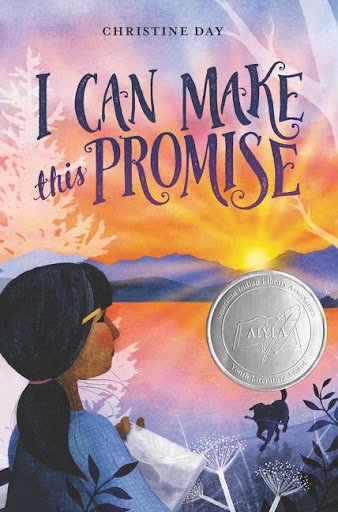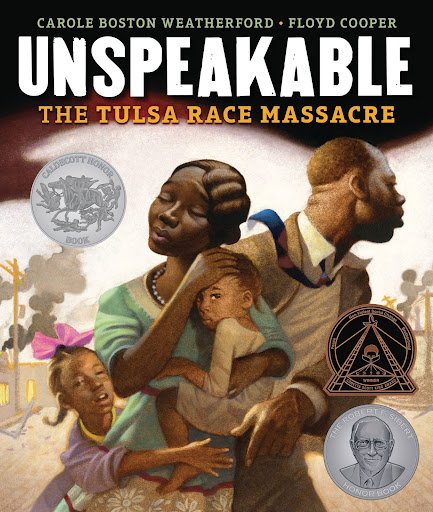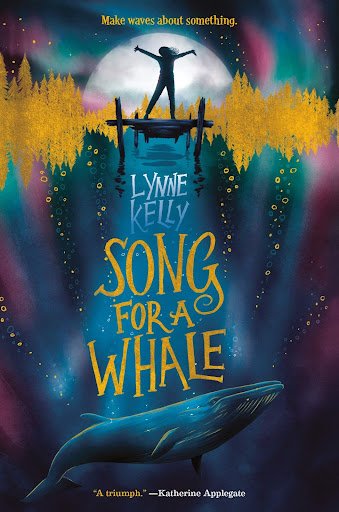By Gabrielle Ahulii Ferreira Holt
“Books are sometimes windows, offering views of worlds that may be real or imagined, familiar or strange. These windows are also sliding glass doors, and readers have only to walk through in imagination to become part of whatever world has been created or recreated by the author. When lighting conditions are just right, however, a window can also be a mirror. Literature transforms human experience and reflects it back to us, and in that reflection we can see our own lives and experiences as part of the larger human experience. ”
Progressive education is guided by the idea that we must actively prepare children for participation in a diverse democracy. In this blog I want to lend my expertise as a school librarian to share how I translate this progressive philosophy into practice. I want to speak to the powerful role that culturally responsive and sustaining children’s literature can play in helping educators achieve this goal. Responsible for building and maintaining school and classroom libraries, I’ll share how I carefully consider book selections that provide children with tools for developing empathy and potential frameworks for thinking about, assessing, and accepting (or challenging) the world around them. I’ll explain how I consider books that will both allow children to step into another’s experience and provide them with a mirror that reflects their own experiences back at them. As Rudine Sims Bishop, author of the quote above, states, “when children cannot find themselves reflected in the books they read, or when the images are distorted, negative, or laughable, they learn a powerful lesson about how they are devalued in the society of which they are a part.” This is why creating library collections with authentic windows and mirrors–books that truly reflect a community’s experience–is an essential progressive education practice. To follow are a few guidelines I use when assessing and selecting books. They are things I think about and strategies that I have crafted from many resources and many hours of research.
ASSESSING BOOKS WITH NATIVE HAWAIIAN & PACIFIC ISLANDER CONTENT/CHARACTERS
May is celebrated as Asian American & Pacific Islander month–yet in many cases the celebration of AAPI experiences does not include Pacific Islanders. The conflation of these two identities is indeed problematic; it leads to erasure of many peoples’ experiences and hides disparities faced by various Pacific Islander communities, both in Hawai‘i and on the continent. In fact, in researching for this blog, I encountered many book lists with titles like “Children’s Books to Celebrate Asian American Pacific Islander Heritage” that featured zero titles by or about Pacific Islanders. One list that featured 70 titles had one Pacific Islander publication. This is despite an extremely rich & thriving Pasifika publishing community!
In Hawai‘i, it is vital that we represent Native Hawaiian and Pacific Islander voices in our classrooms and libraries. However, many of the books lauded for featuring Native Hawaiian content are not written by Native Hawaiian writers (Sharks in the Time of Saviors, as an example). As a Kanaka Maoli writer myself, I understand the power that literature can have. Our history was recorded by ingenious, forward thinking individuals and was read by the most literate population of the early 19th century. Information literacy can be a means for self determination–reading about our own history recorded by our own ancestors is a powerful act of reclamation. Native Hawaiian & Pacific Islander representation in children’s literature is a way for our lāhui to thrive; children will feel a sense of pride in their cultures and be encouraged to perpetuate it.
I must also add that Pasifika publishing is thriving in other regions too! Aotearoa/New Zealand, Tahiti, and Samoa (amongst others) are all publishing children’s books in multilingual versions, ensuring the perpetuation of culture and language for generations to come. There are many resources available to help develop a strong Pacific Islander presence in your library. For example, the NZ Pacific Picture Book Collection, Wheelers new book release list, and Native Books (Honolulu), are all fantastic resources.
To get started, here are some questions I ask about Pasifika/Native Hawaiian books:
Is the author Native Hawaiian or Pacific Islander? This seems obvious, but it is important to assess. A startling number of books that feature Native Hawaiian or Pacific Islander characters are not written by authors that belong to our community.
Does my library collection represent voices from all over the Pacific? The Pasifika region is vast and populated by many cultural groups. Epeli Hau‘ofa stated that Pasifika was a “sea of islands” rather than “islands in a sea.” While we have many similarities, our histories are also different, and should be celebrated and honored in their differences. Helping children draw connections across Pacific cultures is also a great way to build empathy for our many communities in Hawai‘i.
Does the book use the word “folklore”, “folktale”, etc.? Many books that feature Pasifika voices are collections of legends, creation tales, chants, etc. For many of us, these narratives are not just “stories”, but our genealogies. If a collection refers to these as “folktales,” it erases the layers of knowing embedded within them.
We are blessed to have in our community such a wealth of Pasifika knowledge. Draw from communities around you in order to deepen your understanding, and to make connections between your school and the wider community. This can also be an opportunity for your students to become Pasifika writers themselves–writing down family mo‘olelo can be a powerful act of self-determination and will empower them to contribute to Pasifika literature!
ASSESSING BOOKS FEATURING INDIGENOUS, NATIVE AND FIRST NATIONS CHARACTERS
As a Native Hawaiian librarian, I try to be especially aware of how other Indigenous peoples are portrayed in books that I select. Confronting stereotypes in children’s literature is almost a daily occurrence. I can still remember the first time I read a children’s book that featured a “Hawaiian” character–that sinking feeling I felt when reading this book as an eight year old has stuck with me ever since. It wasn’t just that it was a shallow representation–there was also a clear lack of research done that stood in defiance as to how I understood my world as a Hawaiian. This experience is not unique to me–many Native and Indigenous people express this feeling when reading books in school.
A great resource for selecting & purchasing books that feature Indigenous or Native Characters is Dr. Debbie Reese’s blog American Indians in Children’s Literature. Dr. Reese was also recently interviewed in the Learning for Justice magazine, and in it she discusses how book bans are a manifestation of a “fear of a just society.” Other great resources include the American Indian Library Association’s annual book awards and the University of British Columbia’s awesome LibGuide for First Nations literature. The University of British Columbia has a First Nations library, so their librarians are incredibly knowledgeable on this topic!
Some questions I ask when assessing books that feature Indigenous/First Nations characters are:
Does the author use specificity of language? Do the characters belong to a named, specific Native nation? Does the author use the term “nation” rather than “culture” or “tribe”?
Does the author speak of Native/Indigenous/First Nations people as if they exist only in the past? Native & Indigenous people exist today; therefore, content written about Native & Indigenous people should use current tense and contemporary language wherever possible. Being mindful about selecting books that take place in the present day is also important–Native characters shouldn’t be relegated to Historical Fiction.
Does the author belong to the native nation that they are writing about? If not, does the author have a deep relationship with the nation in question? I once read the phrase “I hadn’t held their babies yet” when referring to the work an author had to do, and I think that is a great guideline.
Does the book use stereotypes or tropes? This seems simple, but it is worth noting that many books celebrated as examples of diverse literature often feature stereotypes of other groups (see Amazing Grace as an example). Likewise, does the book use problematic phrases? Examples include: "indian giver", "bury the hatchet", "circle the wagons", "hold down the fort", etc. A white character flippantly using the term “spirit animal” is a big red flag as well.
Does this book refer to or describe lands/spaces/territories as “empty”, or “terra nullius”? One problematic way that books often deal with land is to refer to it as unoccupied land. We know this to be untrue! There is no such thing as “untouched” land. Native peoples’ territories spanned basically every continent, and to not acknowledge that is to participate in erasure.
Lastly, it should be noted that many, many entries in the “western canon of children’s literature” contain problematic and destructive content pertaining to Native people. Books like Little House on the Prairie, Island of the Blue Dolphins (anything by Scott O’Dell, really), The Indian in the Cupboard…the list goes on. There are many alternatives to these books, and if children do choose to read them, we can help create readers and learners who read them with a much more critical eye.
ASSESSING BOOKS ABOUT BLACK HISTORY IN AMERICA
A great place to start is always the Coretta Scott King awards. They award illustrators and authors, with content ranging from elementary to young adult. In this blog I wanted to focus on, in particular, texts that explore the history of Black people in America. While books about Civil Rights are ubiquitous, not all are created equal. Some questions I ask are:
Does it place the history of enslaved people in this country in context? Does it talk about chattel slavery in this country as if it is ancient history? Or rather, a system that still influences us to this day?
What terminology does it use? Does it say “enslaved people” rather than “slaves”? For example: rather than the term “runaway slave”, they have “self-emancipated.” Rather than “slave owner”, a “person who owned human beings”. This may be a teachable moment for students and teachers, which encourages the readers to change the phrases in their head as they encounter them. If you read aloud a book, do the same thing. Call attention to it as well. Rich discussion can be had around active vs. passive language.
Does it talk about the Civil Rights struggle as a struggle for material rights? Or instead, does it talk about the systems & institutions that the movement was created to destroy in the first place? Some books overly simplify the movement, which leads children to a much more shallow understanding of what the movement was fighting for. Children are absolutely capable of understanding what rights and structural change the movement was dedicated to.
Who is telling the story? The author’s identity is vitally important, as is the way in which the story is told. Are Black characters granted agency or is someone else telling the story for them?
ASSESSING BOOKS FEATURING CHARACTERS WITH DISABILITIES
When looking for books tackling ableism, the Schneider Family Book award is a great place to start. Dolly Gray Children’s Literature Award is another. Ableism is particularly prevalent in children’s literature, manifesting in ableist plots and ableist language. Lydia X. Z. Brown’s blog has an incredibly thorough guide on ableist language to avoid in writing and reading. When assessing books featuring a character with a disability, I ask these critical questions:
Is the character described as being “wheelchair bound”, or any variation of this that implies their disability is a burden?
Is the character’s disability treated as something to be “overcome”? Does the plot revolve around them somehow “overcoming” their disability, or is it treated as a triumph to be seen as “abled”? The character’s disability should never be described this way.
Does the book use specific, non-condescending terms? “Differently abled” is condescending. As always, it is better if the book uses specific terminology. A “person who uses a wheelchair”, a Deaf person, etc. Person first language is vital.
Is the character with a disability written as a fully three dimensional character with personhood? Is the character portrayed only as a victim or only as a hero?
ASSESSING FATPHOBIA IN CHILDREN'S LITERATURE
Another prejudice wildly present in children’s literature is Fatphobia. In many, many popular books, the villains/antagonists are either explicitly described as fat, or “fat-coded” (examples include Harry Potter, many Roald Dahl books, the Funjungle series, Hoot). We also see fat characters treated solely as victims. When all the character experiences in the book is bullying, a lack of self-worth, and/or other personal tragedies, it causes children to absorb the idea that fatness is inherently negative. Rebecca Rabinowitz writes, “fatness is mapped onto negative characteristics as if it were some sort of profound literary symbol, and as if such mapping were harmless to people in the real world.” While we often teach children body positivity, it is also important to emphasize body neutrality–we accept our bodies as they are! It may be even more radical to practice body neutrality, as it allows us the freedom to not be preoccupied with our body. For many, practicing body neutrality is a more accessible step away from imposed body negativity–our ingrained ideas of a “normal, healthy” body are often so pervasive, it can be almost impossible for people to reach 100% positivity about themselves.
Asking these questions about books will help your collection become more accepting and inclusive of all bodies:
Is the fat character portrayed only as a victim, or do they have a three-dimensional life experience typically afforded non-fat characters? Too many fat characters are the victims of bullying, tragic life circumstances, or other backgrounds that will ingrain in children the (incorrect) connection between fatness and unhappiness.
Is the only fat character the villain? Many villains in classic children’s literature are described as fat, which creates in children’s minds a connection between fatness and negative, villainous qualities.
If the book features a fat protagonist, does the plot revolve around being fat? Protagonists who are fat should be allowed the same plots and character arcs as non-fat characters–rather than the plot revolve around their body, it should focus on a central problem that explores their personhood (their curiosity, bravery, ingenuity, resilience–all traits that we exalt as heroic and positive).
This is a lot to think about, but in conclusion, my greatest tools and recommendations when assessing books are as follows:
Sensitive, specific language: This is so key. The only way we dismantle these oppressive systems of privileged language is to reinforce it in our reading and speaking. Speaking more specific terms out loud, even if the book doesn’t contain it, trains us as educators to be aware.
Mirrors, windows, and sliding glass doors: My biggest question is usually, “if a child reads a book that is supposed to reflect their experience, will they love the reflection they find?” Will this book truly reflect facets of their identity, or will it create an experience of dissonance?
Don’t be afraid to model critical behavior! If you are reading a book out loud and it contains a stereotype, call it out as you read. Say, “I’m going to stop here so we can talk about this page….” and launch a discussion from there.
Encourage teachers to look outside the “canon.” As accessible as you can make your diverse book collection, the better. Become comfortable enough to suggest alternatives to “classic” literature that you know is problematic.
“Our children are Native every day.” Dr. Debbie Reese states this at the end of her Learning for Justice interview, and I think it is an excellent reminder for all educators. Use culturally responsive and diverse books in your classroom all year–not just during Latinx Heritage Month, Black History Month, Lunar New Year, etc.
All children deserve to see themselves reflected in the literature they read. Children also deserve empathy from their peers around the world, which can be aided by the use of literature that is truly representative of all children’s experiences. This is the promise and potential of the progressive education movement and is the reason culturally responsive and sustaining library collections help to move us all forward in the creation of a diverse democracy.
Works Cited:
Bishop, R. S. (1990). “Multicultural literacy: Mirrors, windows and sliding glass doors.” Perspectives: Choosing and using books for the classroom 6, no. 3. www.psdschools.org/webfm/8559.
Crisp, T., Knezek, S. M., & Gardner, R. P. (2021). Reading and teaching with diverse nonfiction children's books: Representations and possibilities. National Council of Teachers of English.
Dillard, C., & Keels, C. L. (2022). "Our Children Are Native Every Day" : Book Bans and the Fear of a Just Society. Learning For Justice, (2), 33–36.
Rabinowitz, R. (2013, May 13). Diversity 101: Who's that fat kid? Diversity 101: Who's That Fat Kid? Retrieved May 20, 2022, from http://cbcdiversity.blogspot.com/2013/05/diversity-101-whos-that-fat-kid.html
ABOUT THE AUTHOR:
Gabrielle Ahulii Ferreira Holt is the librarian at Hanahau‘oli School, a 104 year old progressive school located in the ahupua‘a of Makiki / Honolulu, in the moku of Kona, on the island of O‘ahu. She has a BFA from the University of British Columbia and an MLIS from the University of Hawai‘i. She has published a series of Hawaiian legend adaptations with BeachHouse publishing, and is currently writing a Hawaiian legend adaptation for Capstone press. She was born and raised in Honolulu.








